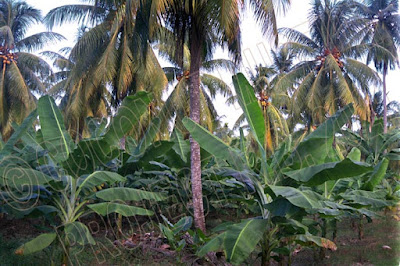©R. Bourdeix, 2021, section 10-CACI. Intercropping in preparation.
For illustrating this section, we can produce on request at least one large size HD poster (up to 180x100 cm in size).
These posters should be adapted to each country, on a case-by-case basis, in order to prominently feature locally produced coconut products, and to promote the marketing of these local products.
It is also possible to buy or rent items from the personal collection of Dr R. Bourdeix.
Growing of intercrops in coconut lands produces more food
and agricultural products, ensuring food security of the people in rural and
urban areas. At the same time, the practice generates jobs and livelihood,
enhancing farm incomes and the purchasing power of people, thus alleviating
poverty in farming communities (Magat 2004). Here are some advantages and disadvantages of intercropping
coconuts:
Advantages
- Increased and diversified farm income.
- Reduced dependence upon coconut products with unstable market prices.
- Improved growth and yields of coconut palms and ease in finding the fallen nuts due to management of intercrop through weed control, use of fertilizers, etc.
- Intercropped plants such as bananas and pineapples provide income in the shortterm, as it takes young palms six or seven years to produce economic yields.
- Better use of good quality land located close to settlements.
- Canopy lowers air temperatures by 4–6°C lower and gives higher air relative humidity. These reduce evaporation from the soil and lower crop transpiration rates maintaining higher level of soil water availability for intercrops.
- Competition between intercrops and coconut, for water or plant nutrients.
- Intercrops may incur losses to farmer if planted where light is insufficient.
- Intercrops may harbour diseases or attract pests harmful to coconuts.
- Fertilisers needed for intercropping may not be affordable.
- Tillage for intercrops may damage shallow-rooted palms reducing copra yields.
- The growth habit of some intercrops may cause difficulty in harvesting coconuts.
- Intercropping demands a higher level of skill from the farmer.
Wildfire sometimes appears to be a major disincentive to establishing forestry and agroforestry intercropping, with various reasons for lighting fires being identified. On the other hand, coconut, citrus and pineapple are considered as fire-retardant food and may provide an incentive for the community to protect planted areas by using firebreaks around the reforestation sites.
.
 |
.
...




